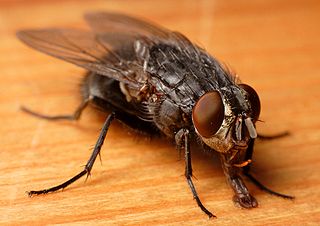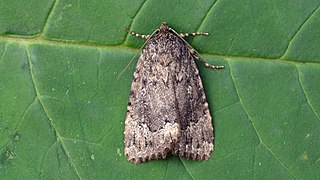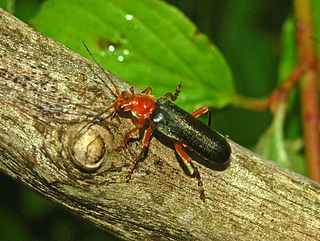
The Calliphoridae are a family of insects in the order Diptera, with almost 1,900 known species. The maggot larvae, often used as fishing bait, are known as gentles. The family is known to be polyphyletic, but much remains disputed regarding proper treatment of the constituent taxa, some of which are occasionally accorded family status.

Melampyrum is a genus of about 20 species of herbaceous flowering plants in the family Orobanchaceae known commonly as cow wheat. They are native to temperate regions of the Northern Hemisphere. They are hemiparasites on other plants, obtaining water and nutrients from host plants, though some are able to survive on their own without parasitising other plants.

The copper underwing, humped green fruitworm or pyramidal green fruitworm is a moth of the family Noctuidae. The species was first described by Carl Linnaeus in his 1758 10th edition of Systema Naturae.

Svensson's copper underwing is a moth of the family Noctuidae. The species was first described by Charles E. Rungs in 1949. It is distributed throughout Europe including Russia east to the Urals.

Calliphora is a genus of blow flies, also known as bottle flies, found in most parts of the world, with the highest diversity in Australia. The most widespread species in North America area Calliphora livida, C. vicina, and C. vomitoria.

Empididae is a family of flies with over 3,000 described species occurring worldwide in all the biogeographic realms but the majority are found in the Holarctic. They are mainly predatory flies like most of their relatives in the Empidoidea, and exhibit a wide range of forms but are generally small to medium-sized, non-metallic and rather bristly.

Amphipyra is a genus of moths in the family Noctuidae, the only genus in the tribe Amphipyrini.

Syntelia is a genus of beetles. It is the only genus in the family Synteliidae. There are seven known species, which are native to high-elevation regions in southern North America from central Mexico to Guatemala, and in eastern Asia, from India to Japan and eastern Russia. They are generally associated with rotting logs, typically found under bark, though the Mexican species S. westwoodi has been found inside large decaying columnar cacti. Adults and larvae are predatory, feeding on insect larvae. A fossil species, Syntelia sunwukong, is known from the Late Cretaceous (Cenomanian) aged Burmese amber of Myanmar. Adults are around 1–3.5 centimetres (0.39–1.38 in) in length. The characteristics of the family and genus include geniculate antennae with 3-segmented club, elongate body, narrowly separated coxae and tarsi with bisetose empodia. Only one abdominal segment is exposed behind elytra. The genus described by John O. Westwood in 1864, while the family was erected by George Lewis in 1882. They are members of Histeroidea, which also includes clown beetles (Histeridae).

Amphipyra pyramidoides, the copper underwing, is a species of moth in the family Noctuidae. It is found in the US and southern Canada.

Calliphora livida is a member of the family Calliphoridae, the blow flies. This large family includes the genus Calliphora, the "blue bottle flies". This genus is important in the field of forensic entomology because of its value in post-mortem interval estimation.

Amphipyra perflua is a moth in the family Noctuidae. It is found from Northern Europe, through Siberia as far east as Korea.

Amphipyra glabella, the grey amphipyra or smooth amphipyra, is a moth in the family Noctuidae. The species was first described by Herbert Knowles Morrison in 1874. It is found in the Eastern parts of the United States and Canada.

Empis livida is a species of fly in the Empididae family. It is included in the subgenus Kritempis of the genus Empis. Males range from 7.5 to 9.3 millimetres, females 7.5 to 10.2 millimetres. The male's abdomen is brownish and its wings appear faintly brown and clouded. The female's abdomen is gray and its wings are clear. E. livida lives in hedgerows, feeding on the nectar of several species of Rosaceae, several species of Asteraceae, and Heracleum sphondylium nectar; they also feed on other insects. They live all across temperate and Northern Europe, the only species with such a wide distribution. E. livida larvae are also carnivorous and live in damp soil and leaf litter. Adults fly in between April and July.

Amphipyra micans is a moth in the family Noctuidae. It is found from Bulgaria and the Balkans south to Greece, east to Turkey and south to Lebanon.

Anthene butleri, the pale hairtail or Butler's ciliate blue, is a butterfly of the family Lycaenidae. It is found from South Africa to Kenya, Uganda, and Ethiopia. In South Africa it is found in coastal lowland forest in KwaZulu-Natal, from the coast to Kosi Bay, inland across the Makathini Flats.

Amphipyra effusa is a moth in the family Noctuidae. It is found from the Mediterranean region and Asia.

Pseudovadonia livida, the fairy-ring longhorn beetle, is a beetle species of flower longhorns belonging to the family Cerambycidae, subfamily Lepturinae.

Tenthredo livida is a sawfly species belonging to the family Tenthredinidae, subfamily Tenthredininae.
Decliniidae is a family of beetles belonging to Scirtoidea. It contains the single genus Declinia with two species, D. relicta and D. versicolor, found in the Russian Far East and Japan, respectively. Little is known of their ecology, and their larvae are unknown. Specimens of D. relicta were found with pollen grains in their gut.

Cantharis livida is a species of soldier beetle belonging to the genus Cantharis family Cantharidae.















